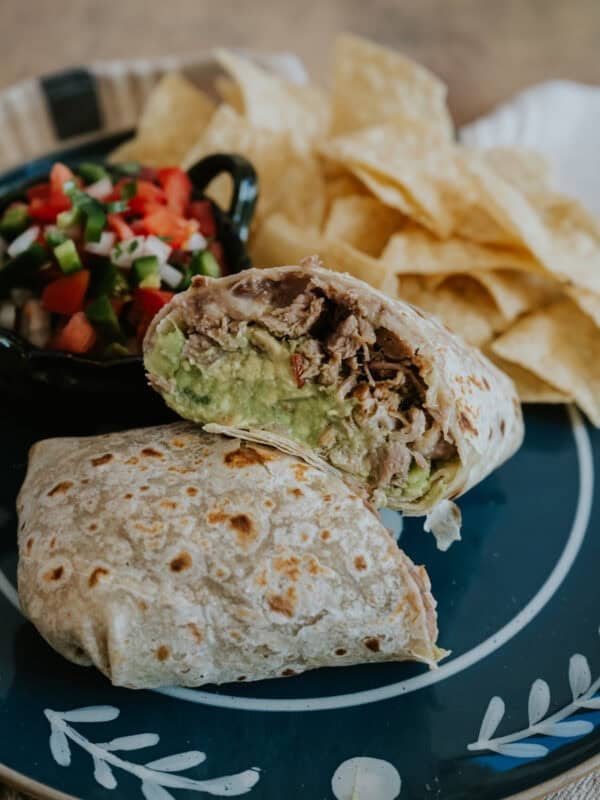Pan de Muerto (Bread of the Dead)
51
Updated Jan 30, 2021, Published Oct 28, 2011
This post may contain affiliate links. Please read our disclosure policy.
Día de los Muertos (Day of the Dead) is an ancient Mexican holiday dating back 3,000 years. It’s celebrated November 1st and 2nd. This holiday was created as a time to remember and honor our loved ones who have passed away by getting together and enjoying all their favorite things including their favorite food and drink.
One of the more traditional dishes seen at Día de los Muertos celebrations is Pan de Muerto (Bread of the Dead). This traditional round loaf of bread has strips of dough rolled out and attached on top to represent bones and skulls. This bread is eaten and left on gravesites or on altars as part of the festivities.
This year I was determined to make Pan de Muerto from scratch versus buying it at a store. I have a permanent altar in our home for my grandma and I thought it was about time I tried making this bread myself. Grandma loved her pan dulce (sweet bread) and cafecito (coffee) in the mornings. Making it with my children, in her memory, made it extra special.
I searched for recipes online, and eventually decided to make my own recipe. I basically used this dough recipe on What’s Cooking America. The addition of the anise and orange glaze really caught my attention. Then I stumbled on Ben’s post on What’s Cooking, Mexico? and liked his idea of the orange flavor in the dough using orange zest and orange blossom water. I substituted orange extract instead of orange blossom water. This video also really helped me understand how to make this delicious bread. I chose to make three small loaves to try several different glazes and sugar finishes. I loved the hint of orange and anise.
Last year, we honored my grandma with a colorful altar and all her favorite items like the veil she wore to church and her rosary. Read the post here and see the amazing photo shoot by Jeanine. It is one of our proudest photo shoots to date. A true tribute honoring my grandma. This year I took the time to honor her memory by baking and eating homemade Pan de Muerto. I’ll enjoy it with a cafecito just like she enjoyed her pan dulce every morning.
Try not to eat them all at once! Don’t forget to leave a loaf on your altar with a glass of water which is essential, because after the journey the souls are thirsty and tired. I am so overwhelmed with how lovely these loaves look. All this work made me feel like I was truly honoring my grandmother.
We’d love to hear from you. Have you ever made or tasted pan de muerto?


Pan de Muerto (Bread of the Dead)
Ingredients
- 1 stick of unsalted butter
- ½ cup milk
- ½ cup water
- 5 to 5 ½ cups all-purpose flour, divided
- 2 packages active-dry yeast
- 1 teaspoon salt
- 1 tablespoon whole anise seed
- ½ cup granulated sugar
- 2 tablespoons orange extract
- Zest of one orange
- 4 eggs
- Orange glaze, see below (optional)
Orange Glaze:
- ½ cup granulated sugar
- 2 tablespoons grated orange zest
- 1/3 cup freshly-squeezed orange juice
Instructions
- In a saucepan over medium heat, warm butter, milk, and water; until butter has melted. Do not let boil.
- In a large mixing bowl, combine ½ cup of flour, yeast, salt, anise seed, and sugar. Slowly beat in the warm milk, orange extract, and orange zest until well mixed. Add eggs, one at a time, mixing through. Slowly add in another 1 cup of flour. Continue adding additional flour until the dough is soft but not sticky.
- Turn the dough out onto a lightly-floured board and knead for at least 10 minutes or until smooth and elastic. If the dough is dry add some water and if it’s too wet add some flour. Form the dough into a large ball and cut into four even pieces.
- Lightly grease a cookie sheet and place three dough balls on it. Cover loosely with plastic wrap and let rise in warm place until doubled in size, approximately 1 to 1 ½ hours.
- Reserve the fourth dough ball to make bones to place over the loaves. Reserve this dough in the refrigerator to slow down the rising process.
- Follow this video for instructions on how to decorate the bread.
- Preheat oven to 350 degrees F.
- Bake bread for approximately 25 to 30 minutes. When the bread is done it should sound “hollow” when thumped.
- In a saucepan over medium heat, combine sugar, orange zest, and orange juice; bring just to a boil so the sugar is completely dissolved. Remove from heat.
- Remove loaf from the oven and brush with the Orange Glaze.
- Another option is to melt two tablespoons of butter in a small pot. As soon as the bread comes out of the oven brush with melted butter and sprinkle sugar over them.
- Let the bread cool down and enjoy with a cup of Champurrado or cafecito.
Notes
Nutrition
Nutrition information is automatically calculated, so should only be used as an approximation.
Photography by Jeanine Thurston

















Can you use a whole anise seed but crush it and does it need orange extract , cant seem to find it.
No need to crush the anise seeds. Keep whole. Fresh orange juice or orange liqueur are great substitutes for orange extract.
Thank you for the excellent recipe! I used it to make loaves for my middle school English as a Second Language classes as part of our cultural study of Dia de los Muertos. It was a big hit and even better than the pan de muerto I’ve bought from Hispanic grocery stores! I will definitely be using your recipe again!
So delicious! Great fluffy texture and sweet orange flavor.
I work for a public library, and am making a short booklet about the history of Dia de los Muertos to include in Sugar Skull Take & Make kits we are giving out for free. May I have your permission to include your Pan de Muerto bread recipe in the booklet? I will of course include your website in the citation.
Can you freeze a loaf? I made this today and it was delicious! Easier than I thought it would be.
So happy to hear that Penny! Thank you. Yes, you can freeze — make sure you allow it to cool before freezing to avoid soggy bread or mold. Wrap it tightly in plastic wrap. Then wrap it again in foil or freezer paper — try to use it within six months.
Me encantó mucho esta receta! Do you also have the recipe in Spanish? I know someone who wants to try, but she only speaks Spanish
Hi, not sure if I’ll be getting a response since this was posted awhile ago, but approximately what size are the finished loaves?
They are about 5 to 6 inches wide.
Thank you so much!
Wow! This looks incredibly delicious.